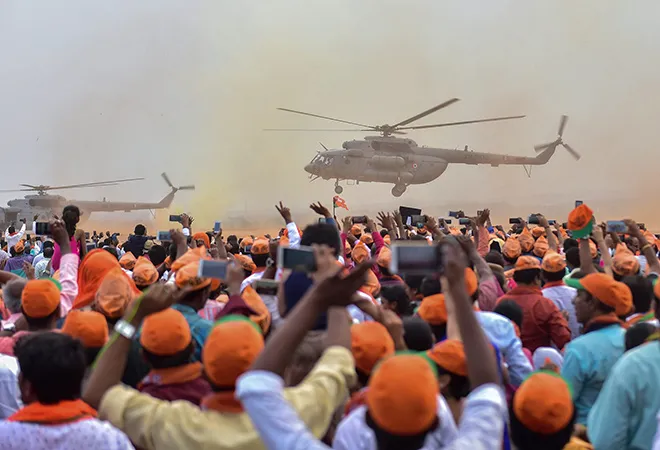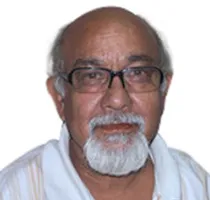-
CENTRES
Progammes & Centres
Location
It is difficult to predict which party’s political strategy will succeed.

Earlier this month, the 16th Lok Sabha met for the last time, and Prime Minister Narendra Modi made two powerful speeches, indicating he is already in the election campaign mode. At the same time, the opposition parties are busy trying to show their unity and working out their strategy. With the general elections less than three months away, the country is witnessing emerging contours of the electoral strategies of the warring opponents. It looks like the elections, expected to be held between April and May this year, may turn out to be bitter and dirty.
The recent terrorist attack at Pulwama in Jammu and Kashmir, killing over 40 CRPF personnel on 15 February, has now added an additional dimension to the coming electoral war as it has created a nationwide outrage.
While the combined opposition, with few exceptions of some regional parties, has decided to primarily focus on issues of unemployment, agrarian crisis and destruction of autonomous institutions, the BJP-led NDA is going to aggressively project its opponents, including the Congress, as Maha-Milavat (highly adulterated) of corrupt and unprincipled political parties and their leaders.
The recent terrorist attack at Pulwama in Jammu and Kashmir, killing over 40 CRPF personnel on 15 February, has now added an additional dimension to the coming electoral war as it has created a nationwide outrage.
Union Minister Arun Jaitley, who recently returned from the US after a surgery, called the opposition alliance as “Mahajhootgathbandhan” (grand alliance of big lies), making it clear that the coming electoral battle is going to be dirty and bitter.
The BJP strategy was more than evident in the final two speeches of Prime Minister Narendra Modi that he gave on 7 & 13 February in the Lok Sabha while replying to the motion of thanks to the President’s address to the joint session of parliament and the farewell address on the last day of the last session of the lower house.
In his final speech in parliament before the general elections, the Prime Minister was in his elements of being a perpetual electoral campaigner as he did not miss to attack Rahul Gandhi by taking a dig at him for hugging him in July last year, followed by the wink.
While Modi heaped praise on all and sundry but the Congress president whom he apparently perceives as the chief political adversary in the electoral mathematics of the country.
Earlier on 7 February, Modi took a swipe at the opposition alliance, saying that the people of the country did not want a highly adulterated government of leaders who assembled at a rally in Kolkata.
Targeting the opposition alliance, he said its leaders are “out on bail in wholesale.” Modi also said that the extradition of some of the accused in the AgustaWestland helicopter deal was giving jitters to many in the opposition as “razdars” (those who keep secrets) were returning and will spill the beans.
The Prime Minister alleged that during the previous UPA regime, there have been instances when people availed loans from banks following phone calls from higher ups in the government.
Notwithstanding the Prime Minister’s attack on the opposition parties, mainly the Congress, in the Lok Sabha, recent raids and the questioning of former UP chief ministers Mayawati and Akhilesh Yadav after the two had announced their party’s electoral alliance is not a coincidence but is a part of the intelligently-crafted plan to defame and discredit them in the public eyes. The reopening of the case of misuse of public funds in the installation of hundreds of elephant statues in Lucknow and Noida against the BSP supremo in the apex court could not be dismissed as mere routine or coincidences.
Notwithstanding the Prime Minister’s attack on the opposition parties, mainly the Congress, in the Lok Sabha, recent raids and the questioning of former UP chief ministers Mayawati and Akhilesh Yadav after the two had announced their party’s electoral alliance is not a coincidence but is a part of the intelligently-crafted plan to defame and discredit them in the public eyes.
In the same sequence come the targeting of West Bengal Chief Minister Mamata Banerjee through Kolkata Police Commissioner Rajeev Kumar by the CBI and the summoning of Robert Vadra, the brother-in-law of Congress chief Rahul Gandhi and the husband of newly appointed general secretary Priyanka Gandhi, by the Enforcement Directorate (ED). The ED summoned Vadra after Priyanka Gandhi decided to join active politics.
The ED is already expediting the questioning of former Finance Minister P. Chidambaram and his son Karti Chidambaram in the INX media case so that a chargesheet can be filed in the court that can pave the way for his arrest.
The strategy to target the Congress and other opposition parties and paint them as corrupt has been readied after the Congress began to succeed in denting the Teflon image of the Prime Minister who has been claiming to be incorruptible and invincible. The main component of the strategy is to aggressively present the opposition as a pack of anti-nationalist parties who are in politics to loot the nation. Rashtriya Janata Dal (RJD) leader Laloo Prasad is already in jail and his son Tejaswi Yadav is likely to get summons from the CBI and the ED soon.
The plan has been prepared by BJP President Amit Shah and National Security Advisor Ajit Doval apart from the Prime Minister while keeping the RSS in the loop. It came in the wake of the realisation that the issues of economic development and Ram temple were not going to help the BJP in the coming elections.
In short, the BJP’s strategy is going to be to demolish the opposition by dubbing them as power-seekers, corrupt, dynasty promoters and disjointed leaders who are anti-nationals out to weaken the country. Anti-minority, with particular emphasis on Muslims, will be another dimension of the electoral strategy.
On the other hand, the opposition that has many contradictions is being pushed by the Prime Minister to unite. By the time elections are announced, the opposition is likely to present a common manifesto with electoral understanding and seat adjustments. This is likely to be a serious challenge to Modi and the NDA.
The BJP’s strategy is going to be to demolish the opposition by dubbing them as power-seekers, corrupt, dynasty promoters and disjointed leaders who are anti-nationals out to weaken the country.
The tragedy at Pulwama is bound to impact the electoral psyche of the nation. Whom it is going to benefit electorally will depend upon the course of action and its resultant success or failure that the Modi government is going to follow. The opposition combine does not have much elbow-room for political maneuvering on this count.
It is difficult to predict now whose strategy will succeed. The alliance that catches the people’s attention and ignites public imagination is going to have an upper hand.
In 2014, Modi had won the elections on scores of promises and weaving a dream world free of corruption and full of comfort and high life. But this time, having not successful in fulfilling the dreams, the ruling dispensation is following a different path for victory. It appears that the battle is going to be between the NDA’s rhetoric, coupled with Modi’s aggression and the opposition’s effort to convince the electorate that the Modi government has been a failure.
The outcome of the coming electoral exercise is going to depend upon who will be able to win the perception battle.
The views expressed above belong to the author(s). ORF research and analyses now available on Telegram! Click here to access our curated content — blogs, longforms and interviews.

Satish Misra was Senior Fellow at ORF. He has been a journalist for many years. He has a PhD in International Affairs from Humboldt University ...
Read More +